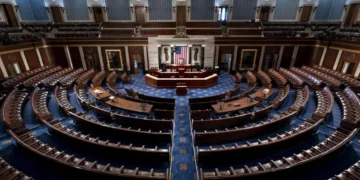Dec 7, 2024 Story by: Editor
Virginia’s gubernatorial race in 2025 is set to make history, as two women are poised to lead their respective party tickets. Lieutenant Governor Winsome Earle-Sears (R) and Representative Abigail Spanberger (D-Va.) have emerged as the leading contenders, with their parties largely consolidating support behind them.
If both Earle-Sears and Spanberger win their primaries, one of them could become Virginia’s first female governor. Additionally, Earle-Sears would achieve a historic milestone as the first Black woman to govern the state, which once served as the capital of the Confederacy.
Virginia political analyst Bob Holsworth highlighted the broader significance, stating, “The Republican Party has been very late to the recruitment, and the Democratic Party depended upon women voters, particularly African American women voters, but didn’t do very much to ascend them to positions.”
The last woman to run in a general election for Virginia governor was Mary Sue Terry (D), who lost to George Allen (R) in 1993 by over 17 points. That election also saw Christine Todd Whitman (R) make history as New Jersey’s first female governor.
While women participated in Virginia’s 2021 gubernatorial race, none advanced to the general election. Amanda Chase (R) competed in the Republican convention but lost to Glenn Youngkin, while Jennifer McClellan (D) and Jennifer Carroll Foy (D) ran in the Democratic primary but were defeated by Terry McAuliffe, who secured 62% of the vote.
This time, the path appears clearer for Earle-Sears and Spanberger. Governor Youngkin has endorsed Earle-Sears, ending speculation about a primary challenge from Attorney General Jason Miyares. On the Democratic side, Richmond Mayor Levar Stoney withdrew from the race in April, paving the way for Spanberger’s candidacy.
“It is really significant that not only are there going to be two women running but that both parties seem to be kind of clearing the field for them, which we have not necessarily seen,” said Debbie Walsh, director of the Center for American Women in Politics at Rutgers University.
Despite gains in legislative representation, female governors remain rare, with only 12 currently in office and 49 in U.S. history. The number will briefly rise to 14 with the transitions of New Hampshire’s governor-elect and Delaware’s lieutenant governor. However, South Dakota’s Kristi Noem is set to leave her post, reducing the count again.
Virginia’s off-year elections often hinge on female voters, particularly Black women, whose political mobilization in legislative races after Donald Trump’s 2016 election signaled a wave of change. In 2018, Black female voters were instrumental in Democratic victories, including Spanberger’s congressional win. Walsh noted, “Women in general are more likely to support the Democratic candidate… but the strongest group for Democratic candidates regardless of the gender of the candidate are Black women.”
Earle-Sears faces challenges in securing support from Black female voters due to Trump’s unpopularity in Virginia, while Spanberger must energize the state’s influential Black electorate—a task she has not tackled extensively in her congressional campaigns. “Critically, she has to do well in the African American community, and she’s never had to do that before,” Holsworth said. He also emphasized the need for robust turnout among Black voters, which had declined from 2020 to 2024.
Both candidates must navigate the dynamics of an off-year election, with significantly lower voter turnout compared to a presidential year. Holsworth pointed out, “There’ll be a million less people who will vote in this election than did in the presidential election,” making turnout strategies pivotal for Spanberger to secure victory. Source: Yahoo News

















